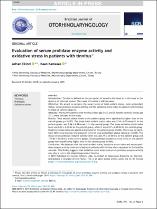Evaluation of serum prolidase enzyme activity and oxidative stress in patients with tinnitus

View/
Access
info:eu-repo/semantics/openAccessAttribution 4.0 International (CC BY 4.0)https://creativecommons.org/licenses/by/4.0/Date
2019Metadata
Show full item recordCitation
Ekinci, A., Kamaşak, K. (2019). Evaluation of serum prolidase enzyme activity and oxidative stress in patients with tinnitus. Brazilian Journal of Otorhinolaryngology.Abstract
Introduction: Tinnitus is defined as the perception of sound in the head or in the head in the absence of external sounds. The cause of tinnitus is still unknown. Objective: We aimed to compare the serum levels of total oxidant status, total antioxidant status, serum prolidase enzyme activity and the oxidative stress index in patients with tinnitus to those of normal subjects. Methods: Twenty five patients with tinnitus (mean age 34.3) and 25 healthy controls (mean age 37.2) were included in the study. Results: Total oxidant status levels in the patient group were significantly higher than in the control group (p = 0.037). The mean total oxidant status value was 2.54 ± 0.95 mmoL/L in the patient group, and 2.06 ± 0.98 mmoL/L in the control group. The mean oxidative stress index level was 0.22 ± 0.10 AU in the patient group, while it was 0.17 ± 0.08 AU in the control group. Oxidative stress index was significantly higher in the patient group (0.026). There was no significant difference between the groups in terms of total antioxidant status values (p = 0.838). The mean serum prolidase enzyme activity level was 202.74 ± 33.56 U/L in the patient group and 175.46 ± 42.68 U/L in the control group. Serum prolidase enzyme activity levels in the patient group were significantly higher than in the control group (0.040). Conclusion: We detected that the total oxidant status, oxidative stress index and serum prolidase enzyme activity levels were higher in patients with tinnitus when compared to the healthy controls. This finding suggests that oxidative stress index and serum prolidase enzyme activity may play a role in the etiopathogenesis of tinnitus. © 2019 Introdução: O zumbido é definido como a percepção de um som na cabeça na ausência de sonsexternos. A causa do zumbido ainda é desconhecida.Objetivo: Nosso objetivo foi comparar os níveis séricos do estado oxidante total, estado antiox-idante total, atividade da enzima prolidase sérica e o índice de estresse oxidativo em pacientescom zumbido e em indivíduos normais.Método: Foram incluídos no estudo vinte e cinco pacientes com zumbido (média de idade de34,3 anos) e 25 controles saudáveis (média de idade de 37,2 anos).Resultados: Os níveis do estado oxidante total no grupo de pacientes foram significantementemaiores do que no grupo controle (p = 0,037). O valor médio do estado oxidante total foi de2,54 ± 0,95 mmoL/L no grupo de pacientes e de 2,06 ± 0,98 mmoL/L no grupo controle. O nívelmédio de índice de estresse oxidativo foi de 0,22 ± 0,10 AU no grupo de pacientes, enquanto nogrupo controle foi de 0,17 ± 0,08 AU. O índice de estresse oxidativo foi significantemente maiorno grupo de pacientes (0,026). Não houve diferença significante entre os grupos em relaçãoaos valores do estado antioxidante total (p = 0,838). O nível médio de atividade da enzimaprolidase sérica foi de 202,74 ± 33,56 U/L no grupo de pacientes e de 175,46 ± 42,68 U/L nogrupo controle. Os níveis de atividade da enzima prolidase sérica no grupo de pacientes foramsignificantemente maiores do que no grupo controle (0,040).Conclusão: Detectamos que os níveis de estado oxidante total, índice de estresse oxidativoe atividade da enzima prolidase sérica foram maiores nos pacientes com zumbido quandocomparados aos controles saudáveis. Este achado sugere que o índice de estresse oxidativoe a atividade da enzima prolidase sérica podem desempenhar um papel na etiopatogenia dozumbido.


















